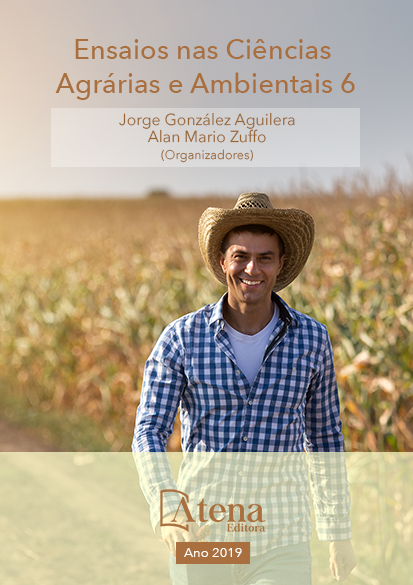
QUANTIFICAÇÃO DA FITOMASSA PARA A COBERTURA DO SOLO EM PLANTIO IRRIGADO
O aprimoramento do Sistema Plantio
Direto (SPD) é algo particular a cada ambiente,
principalmente no que se refere a melhor
combinação entre as espécies cultivadas. O
objetivo da pesquisa foi quantificar a formação
da cobertura vegetal sob plantio direto irrigado
em três etapas de manejo no semiárido potiguar.
O manejo da área foi realizado com o mínimo
de mobilização do sistema solo, priorizando
a formação de fitomassa e a preservação de
suas características anteriores. O delineamento
experimental foi o de blocos ao acaso com
cinco tratamentos e seis repetições para as
condições de manejo na vegetação espontânea
(VE), plantas de cobertura (PC) e milho (M). Os
dados foram submetidos à análise de variância
e ao teste de Tukey a 5% de probabilidade e
constatou-se que dentro dos tratamentos para
o manejo da VE e M não houve diferença
estatística significativa. Ou seja, valor médio da
fitomassa nos tratamentos ficou semelhantes
após a intervenção mecânica. No manejo da
PC as áreas submetidas ao plantio de Milheto
(T1), Crotalária (T2), do Sorgo (T4) e do Sorgo
+ Crotalária (T5) foram semelhantes e T3 (vegetação espontânea) foi a único que
diferiu. Ao final, a quantidade de fitomassa gerada com o manejo de é suficiente para
caracterizar o plantio direto.
QUANTIFICAÇÃO DA FITOMASSA PARA A COBERTURA DO SOLO EM PLANTIO IRRIGADO
-
DOI: 10.22533/at.ed.42119160117
-
Palavras-chave: Plantio direto, Semiárido, Biomassa.
-
Keywords: Direct planting, Semi-arid, Biomass.
-
Abstract:
The improvement of the No-tillage System is particular to each environment,
especially regarding the best combination between cultivated species. The objective of
the research is to quantify the formation of vegetation managed under no-tillage system
tillage irrigated in successive crops of spontaneous vegetation, specific plants for soil
cover and maize crop. The management of the area was carried out with minimum soil
mobilization, prioritizing the formation of phytomass and preservation of its previous
characteristics. The experimental design was a randomized block design with five
treatments and six replications for management conditions in spontaneous vegetation
(SV), cover plants (CP) and maize (M). The data were submitted to variance analysis
and Tukey’s test at 5% probability and it was verified that within the treatments for the
management of the VE and M there was no statistical difference, the average phytomass
value of the treatments were similar after the management. In the management of the
cover plants, the highest values of average were observed in the areas planted with
Crotalaria (T2) and Sorghum (T4), they were statistically higher to the others and T3
treatment (spontaneous vegetation) was the only one that differed. At the end, the
amount of phytomass generated with the management of each cover is sufficient to
characterize the no-tillage
-
Número de páginas: 15
- Jonatan Levi Ferreira de Medeiros


